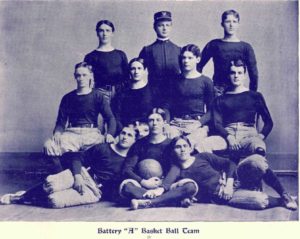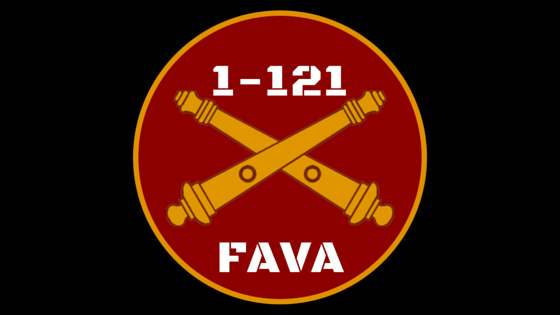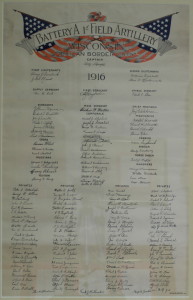“A battery of field artillery is worth a thousand muskets.”
Gen William Tecumseh Sherman
On September 11, 1884, twelve men signed an agreement to organize a field artillery battery in Milwaukee, Wisconsin. The formal organization of the unit occurred on May 11, 1885 with the creation of the 65-member “First Wisconsin Battery.” The Battery quickly changed its name to the “First Light Battery” after complaints from Civil War Veterans who served in the unit 20 years earlier. Joseph B. Oliver, a Civil War Veteran, was named the unit’s first Commander. The unit occupied the Farwell Avenue Skating Rink and trained in a vacant lot on North Prospect Avenue in Milwaukee. As the unit grew, it moved to an armory at 815 N. Broadway which it shared with Milwaukee’s “Light Horse Squadron.”
The early focus of the battery included participation in military competitions, annual summer encampments, and social activities. The unit traveled throughout the midwest and as far as Washington D.C. to participate in competitions. Summe r camps involved moving the entire Battery to destinations within Wisconsin, including Oconto, Ripon, Marinette, and Camp Douglas. Social activities are featured prominently in the unit history, including a stag club known as the “Battery Bucks.” The unit also organized a basketball team and formal dances used to assist in funding activities. Between 1885 and 1916 the unit was called to State or Federal service three times before its eventual participation in the World War.
r camps involved moving the entire Battery to destinations within Wisconsin, including Oconto, Ripon, Marinette, and Camp Douglas. Social activities are featured prominently in the unit history, including a stag club known as the “Battery Bucks.” The unit also organized a basketball team and formal dances used to assist in funding activities. Between 1885 and 1916 the unit was called to State or Federal service three times before its eventual participation in the World War.
Bay View Riot
In May of 1886, Governor Rusk ordered State Militia units to assemble at the Broadway Armory in response to what would be known as the Bay View Labor Riot. The First Light Battery was called to State active duty on May 4, 1886 and having been held in reserve, was released on May 10, 1886.
Spanish American War
On July 9, 1898, Battery “A” 1st Light Artillery mobilized during the Spanish-American War. At the time, Battery “A” was commanded by Captain Benjamin Dally and was made up of 108 artillerymen from the Milwaukee area. The unit arrived at Camp Douglas, WI in early July 1898 and spent the summer training for the potential deployment to Texas. When hostilities ceased in August, the Battery’s services were no longer needed and the unit returned to Milwaukee in September 1898.
Mexican Border Incident
In 1916, the Battery “A” 1st Light Artillery was expanded to a full battalion named the 1st Field Artillery. On June 14, 1916, Battery “A”, 1st Light Artillery was re-designated as Battery “A”, 1st Field Artillery. On June 8, 1916, Battery “B” was established in Green Bay, Wisconsin. On June 12, 1916, Battery “C” was established in Racine, Wisconsin. On June 30, 1916, 157 officers and men of Battery “A”, 1st Field Artillery commanded by Captain Philip C. Westfahl mustered into Federal service at Camp Douglas, Wisconsin. Battery “A” moved to Camp Wilson near San Antonio, Texas on July 1, 1916 where they trained as artillerymen. Battery “A” was released from Federal Service and returned to Wisconsin on October 26, 1916. See links to a medal issued by the City of Milwaukee to members of the Battery and a Battery “A” 1st Light Artillery pennant.
* On small screens, swipe right to left to view entire table *
Commanders
| TO | FROM | UNIT | NAME |
|---|---|---|---|
| 1885 | 1889 | First Light Battery | Joseph B. Oliver |
| 1889 | 1890 | First Light Battery | Howard J. Gilson |
| 1890 | 1891 | First Light Battery | Howard J. Gilson |
| 1891 | 1894 | First Light Battery | Harry E. Ellis |
| 1894 | 1895 | Battery A, 1st Light Artillery | Harry E. Ellis |
| 1895 | 1898 | Battery A, 1st Light Artillery | Benjamin H. Dally |
| 1898 | 1908 | Battery A, 1st Light Artillery | Charles F. Ludington |
| 1908 | 1916 | Battery A, 1st Light Artillery | Phillip C. Westfahl |

